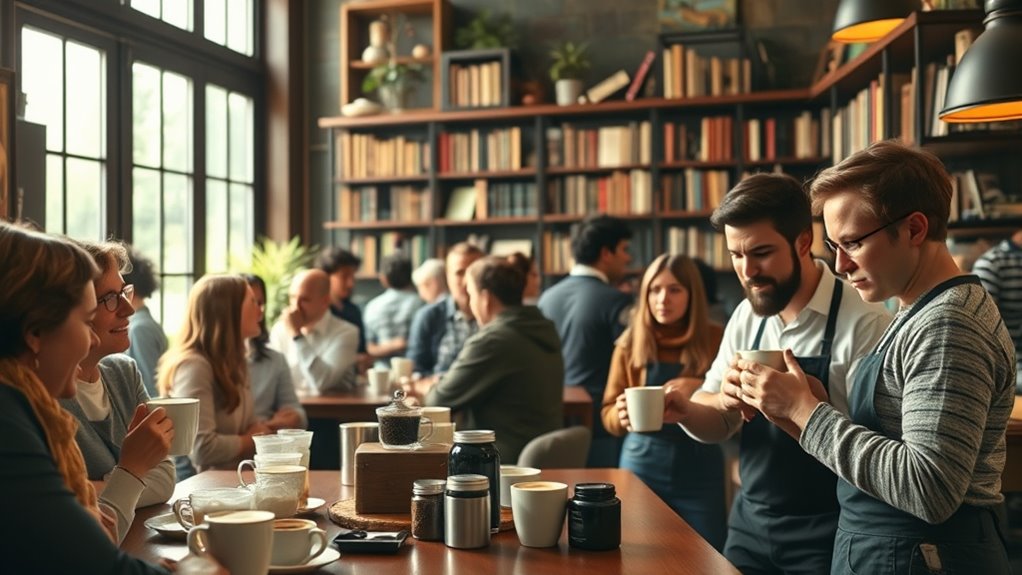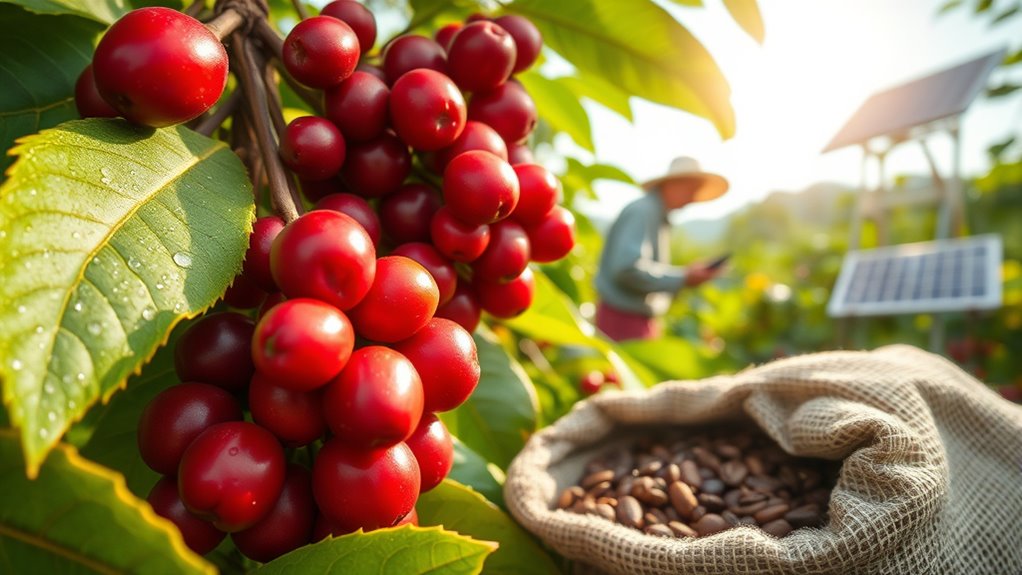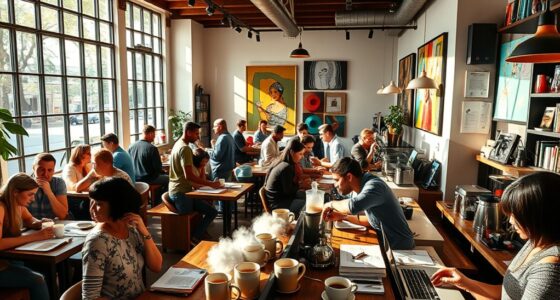Coffee became a global staple by evolving from its Ethiopian roots to a cultural phenomenon. As it spread to Yemen and then Europe, it fostered social interaction in coffeehouses, where ideas flourished. The coffee trade supports millions worldwide, creating jobs and shaping economies. With the rise of espresso culture, coffee transformed into a symbol of socialization, while innovations address current challenges. Discover how coffee’s journey has influenced the world we recognize today.
Key Takeaways
- Coffee originated in Ethiopia and spread to the Arab world, becoming integral in Sufi monasteries by the 15th century.
- The establishment of coffeehouses in Europe during the late 17th century facilitated social interaction and intellectual exchange.
- The global coffee trade now supports over 120 million workers, driving economies in producing countries like Brazil and Colombia.
- Innovations in coffee production and the rise of specialty coffee shops have enhanced its appeal and accessibility worldwide.
- Coffee’s cultural significance as a social beverage has solidified its status as a global staple across diverse societies.
The Origins of Coffee: From Ethiopia to the World

Coffee’s journey began in the highlands of Ethiopia, where the Oromo people first cultivated the Coffea arabica plant. They recognized its stimulating effects, laying the foundations for coffee’s rich origins.
By the 15th century, coffee made its way to Yemen, becoming a staple in Sufi monasteries, where it enhanced focus during prayers. This marked the start of its global expansion.
In the 15th century, coffee became essential in Yemen’s Sufi monasteries, enhancing spiritual focus and igniting its global journey.
In the late 16th century, coffee crossed into Europe, with the first coffee house opening in Venice in 1645, sparking interest across cultures.
As the beverage traveled, its name evolved; the word “coffee” entered English in 1582 from the Dutch term “koffie,” reflecting its cultural journey through various regions, shaping the world’s coffee culture as we understand it today.
The Cultural Significance of Coffee Across Societies

While many people enjoy their morning cup, the cultural significance of coffee extends far beyond mere consumption.
Coffee culture has flourished globally, transforming the beverage into one of the most popular beverages of our time. In countries like Italy and Turkey, it embodies hospitality and social bonding, making it a centerpiece during gatherings.
The emergence of coffee houses in the late 17th century in Western Europe created crucial spaces for intellectual exchange, fostering community connections. These establishments became essential for social interaction, transcending mere caffeine consumption.
As you sip your coffee, remember its rich history and how it’s woven into the fabric of daily life across societies, symbolizing connection and shared experiences.
The Economic Impact of Coffee Trade and Consumption

When you consider the global coffee trade, it’s clear that this beloved beverage plays an essential role in economies worldwide.
Major producers like Brazil and Vietnam rely heavily on coffee, while the demand from countries like the U.S. and Germany creates a complex web of trade dynamics.
As you explore the economic impact, you’ll see how coffee not only supports millions of workers but also shapes local economies in significant ways.
Global Coffee Trade Dynamics
Every day, over two billion cups of coffee are consumed around the globe, underscoring its status as an essential commodity in the international market. The coffee trade greatly impacts global economies, providing livelihoods for over 120 million workers, particularly coffee farmers in developing countries. Major producers like Brazil and Vietnam export vast quantities, while the U.S., Germany, and France are top importers. Historically, coffee houses have been pivotal in economic development, fueling financial institutions. However, challenges like climate change threaten production and supply chains, raising concerns about future consumption levels.
| Major Producers | Top Importers |
|---|---|
| Brazil | United States |
| Vietnam | Germany |
| Colombia | France |
Economic Importance of Producers
The coffee trade plays a meaningful role in shaping the economies of producing nations, where the livelihoods of millions depend on this single crop. As you sip your morning brew, remember that major producers like Brazil, Vietnam, and Colombia contribute meaningfully to their national economies. Brazil alone accounts for about 37% of the world’s coffee supply. Each year, over two billion cups are consumed globally, highlighting the economic importance of coffee beans. This trade is influenced by demand from major importers such as the United States and Germany, affecting prices and market dynamics. Additionally, coffee cultivation can boost local economies by providing essential jobs and fostering community development. Ultimately, coffee cultivation supports over 120 million workers and their families, solidifying its role in providing economic stability and livelihoods for many communities around the world. Additionally, the coffee sector can be viewed as a vital employer-sponsored retirement account that supports local economies through job creation and investment in community development.
Impact on Local Economies
Although coffee often seems like just a morning ritual, its impact on local economies is profound and far-reaching. In coffee-producing countries like Brazil, Vietnam, and Colombia, coffee trade fuels economic growth by providing jobs for over 120 million workers and their families. Additionally, coffee’s health benefits, such as antioxidants that combat oxidative stress, add to its value and appeal, further driving demand. Furthermore, proper nutrition is essential for the health of coffee farmers and their families, influencing productivity and economic stability in these regions. Moreover, maintaining a balanced lifestyle through healthy habits can support the well-being of these communities.
The demand for coffee not only supports livelihoods but also strengthens local economies, as profits circulate within communities. Historically, coffee has shaped economic structures, influencing labor practices and even leading to the establishment of financial institutions in European coffee houses. Additionally, coffee consumption varies significantly across different cultures, highlighting its role as a global beverage that connects diverse communities.
Today, as you sip your coffee, you’re part of a global market that considerably contributes to the economic sustainability and growth of these nations, highlighting the importance of this beloved beverage beyond mere enjoyment.

When you think about the rise of coffeehouses in the late 17th century, it’s clear they were more than just places to grab a cup of joe.
These establishments fostered vibrant discussions, allowing people to share ideas and debate important issues. They shaped the cultural and intellectual landscape, becoming essential venues for revolutionary thought and artistic movements.
Historical Coffeehouse Significance
Coffeehouses emerged as vibrant social hubs in Western Europe during the late 17th century, transforming how people interacted and exchanged ideas. They became meeting places for intellectuals, artists, and businessmen, fostering social interaction across various classes.
By the early 1700s, over 2,000 coffeehouses thrived, markedly contributing to cultural dialogue. In cities like Vienna and Paris, these venues sparked political discussions and debates, influencing societal changes during pivotal historical periods.
Their role in democratizing information was vital; patrons paid little for entry, gaining access to a wealth of knowledge through conversation. Coffeehouses, often dubbed “penny universities,” provided a unique environment where ideas flourished, making them essential to the social fabric of Europe.
Intellectual Exchange Venues
As vibrant social hubs, coffeehouses naturally evolved into venues for intellectual exchange. By the late 17th century, you’d find patrons engaged in lively intellectual discourse, discussing everything from trade to revolutionary ideas.
These establishments acted as cultural centers, particularly in cities like London and Amsterdam, where merchants and thinkers mingled, shaping modern financial institutions.
In the Islamic world, coffeehouses fostered art, literature, and philosophy, greatly influencing intellectual thought during the 15th to 17th centuries.
Notable figures like Voltaire and Rousseau frequented Parisian coffeehouses, contributing to the Enlightenment by debating new concepts.
With rising literacy rates, these venues encouraged patrons to read newspapers and pamphlets, cultivating an informed public enthusiastic for social interaction and knowledge exchange.
The Rise of Espresso and Modern Coffee Culture

With the rise of espresso in the United States, a new era of coffee culture emerged, transforming how people experience and enjoy this beloved beverage. Howard Schultz’s vision of bringing the Italian coffee experience to American culture led to Starbucks’ global expansion in the 1980s. Espresso machines revolutionized coffee preparation, enhancing flavor extraction and making it easier to enjoy high-quality brews. By the late 20th century, specialty coffee shops emphasized artisanal methods, creating social hubs where people connect. This shift highlights the importance of coffee in fostering community.
| Aspect | Description |
|---|---|
| Espresso Machines | Quick brewing for maximum flavor |
| Specialty Coffee | Focus on high-quality, artisanal beans |
| Coffee Shops | Social hubs distinct from home/work |
| American Culture | Coffee as a socialization symbol |
| Global Coffee | Growth in quality and unique experiences |
Challenges and Innovations in Coffee Production Today

Though coffee remains a beloved beverage worldwide, its production faces formidable challenges largely driven by climate change. As temperatures rise and rainfall patterns shift, maintaining the ideal conditions for coffee plants, especially Arabica, becomes increasingly difficult.
Predictions suggest that Brazil might lose up to 25% of suitable Arabica land by 2050. To combat these production challenges, farmers are turning to alternative coffee species like Coffea robusta, which are more resistant to harsh conditions.
Innovations in selective breeding also play a vital role in developing resilient coffee crops that maintain desirable flavors. Research initiatives, like those by Daterra, are essential in identifying new varieties that can thrive despite the ongoing impacts of climate change on coffee cultivation.
Frequently Asked Questions
How Did Coffee Become a Staple?
You’ll find that coffee became a staple through its journey from local beverage to global phenomenon.
Initially embraced for its stimulating effects, it quickly transformed into a social drink in coffeehouses. As trade routes expanded, so did its availability, making it accessible to many.
Events like the Boston Tea Party shifted preferences towards coffee, while innovations in brewing methods and sourcing further solidified its place in daily life, establishing it as a beloved cultural icon.
How Did Coffee Become Popular Around the World?
Did you know that over 2.25 billion cups of coffee are consumed worldwide each day?
Coffee became popular around the globe due to its rich flavor and stimulating effects. It started in Yemen’s Sufi monasteries, then spread to Europe’s coffee houses as social hubs.
When Did Coffee Become a Global Commodity?
Coffee became a global commodity in the 17th century. You’d see European traders importing it from the Middle East, leading to its rise in popularity.
By the late 1600s, coffee houses were popping up in major cities, creating social hubs.
As coffee plantations developed in the Caribbean and South America during the 18th century, especially in Brazil, production soared, solidifying coffee’s status as a key player in the global economy.
Why Did Coffee Gain Popularity?
When it rains, it pours, and coffee’s rise to fame is no exception.
You’ve likely noticed how coffee became a staple in social settings and daily routines. Its enticing aroma and energizing effects drew people in, making it the perfect companion for conversation and contemplation.
From Sufi monks to bustling coffee houses, its appeal only grew. By becoming a symbol of independence and quality, coffee captured hearts, ensuring its lasting popularity.
Conclusion
Coffee’s journey from Ethiopia to becoming a global staple is nothing short of fascinating. Today, over 2.25 billion cups are consumed daily around the world, illustrating its deep-rooted presence in our lives. As you sip your favorite brew, remember that it’s more than just a drink; it’s a cultural phenomenon that connects people across continents. By understanding its history and significance, you can appreciate each cup as part of a rich tapestry woven through time and society.









